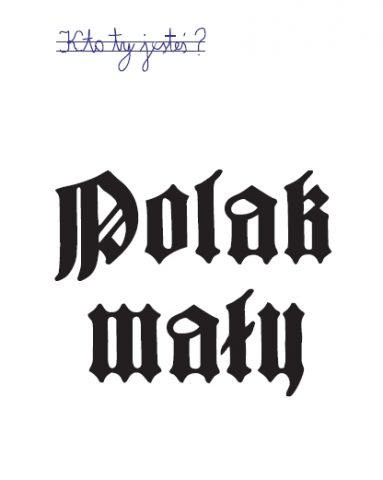Fetishisation of image. New nationalism in Polish mass culture
The subject of my degree dissertation is the phenomenon of new nationalism, which is embodied in the visual layer of contemporary Poland. The aim was to approximate the pattern which I call new nationalism, in which a crisis related to the understanding and operating of the present-day is revealed through images. I tried to answer the question of what lies beneath simple visual messages, which massively disseminate a particular vision of the reception of the world. In my analysis, I started from the surprise that most of these messages are reduced to simple oppositions, clear contrasts. In this case they take the form of white and red.
This dissertation has focused on the visual sphere, primarily on the cultural ways of constructing images, with an attitude of what is seen and how. In the context of new nationalism, it seems important to ask what are the representations from such a perspective. Cultural practices are linked here with politics in the aspect of visualization.
The images processing symbols and motifs taken from the Polish symbolic field became the research material. For a detailed analysis, I chose those that may incorporate new nationalism as a research perspective into the field of visual culture with their content and form. These include the so-called patriotic t-shirt, the patriotic tattoo and Zbigniew Dowgiałło’s painting Smoleńsk.
My research has shown that the layer of symbols known to the Polish society conceal the attitudes related to the social and political conditions of the present-day Poland. Mass culture understood – quote from Marek Krajewski – as a space of manifestation of social control, provides in its field ideologies embodied in images, a significant element of which has become the value of new nationalism. The new nationalism is defined here as a phenomenon characteristic for Poland shaped by mechanisms of globalization, Poland’s presence in European Union structures and scattered anxiety, connected with the state defined by Zygmunt Bauman as postmodern. In this space, nationality in the form of images is constantly reproduced and reminds of the effects of simplification and radicalization of cultural and historical heritage. Representations produced and received under such conditions often are reduced to symbols that are subsequently fetishised and as such, they function in mass culture. The analysis of individual images revealed, among other things, the dissonance between the directness of the message and their actual meaning.
False is often hidden in the aesthetic superstructure of specific ideologies, which was presented using the kitsch research perspective. The analysis of Zbigniew Dowgiałło’s painting Smoleńsk, combining the aesthetic theory of kitsch with its social dimension, has allowed proving that some visual practices directly relate to ethical categories. The painting, thanks to its formal and contextual characteristics, allowed analysis to be conducted, which resulted in aesthetic and social categories being measured on the formal level. One of the characteristics that combine new nationalism, kitsch and visual representations is the construction of a message based on the myth, and consequently the deformation of the actual state of things. This process is realized, among other things, in mass culture objects, which are commonly referred to as “patriotic”. They draw from the national imagery, which according to researchers is founded on trauma. Thus the resulting images, filtered by market forces and consumption mechanisms, should be treated critically. Fetishisation of some national motifs is realized in the mass production of “patriotic” clothing and gadgets, which were subjected to semiotic analysis in this work. The national symbols presented here are in the form of an index sign on the object, which becomes a commodity. Fetishisation is linked in this case to both the commodification of some “values” such as patriotism, and “the lack” addressed by psychoanalysis.
Summarizing the social mechanisms produced by the images analyzed in the work, one can agree with Maffesoli’s opinion in Time of the Tribes that “the collective sensibility which issues from the aesthetic form results in an ethical connection”. The new nationalism is revealed through images that simultaneously drive it. Images should not be underestimated because they reveal not the actual image of the world, but ideology. Quoting Nicolas Mirzoeff: “»Seeing« is not »believing«, it is »intepreting«”. I wanted to approach representations of the new nationalism in the Polish mass culture in this way.

(born 1992)
Studies: Faculty of Art Education, Poznań University of Arts (first-cycle 2012–2015); Faculty of Visual Culture at the Academy of Fine Arts in Warsaw (second-cycle, 2015–2017); graphic design at Władysław Strzemiński Academy of Fine Arts in Łódź (postgraduate 2016/17). Internships at the Center for Contemporary Art FUTURA in Prague (2016) and the SYNTAX Gallery in Lisbon (2017). In the years 2015–2017 she worked in BWA Gallery in Warsaw.

